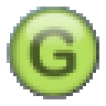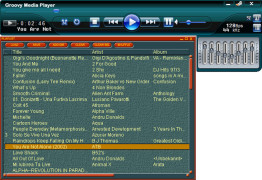
Groovy
by Groovy Team
Groovy is a powerful, dynamic and versatile programming language that provides a syntax and feature-rich environment for developers to quickly and easily develop applications.
Operating system: Windows
Publisher: Groovy Team
Release : Groovy 5.0.0
Antivirus check: passed
Groovy
Groovy is a powerful and flexible open-source software development tool that enables developers to quickly and easily create reliable, robust and maintainable applications. It is based on the Java platform and provides an intuitive, easy-to-learn syntax for developing applications that can be deployed to the Java Virtual Machine (JVM).
• Object-oriented Programming: Groovy supports object-oriented paradigms such as classes, interfaces, and inheritance. It also provides a concise syntax that makes programming easier and more efficient.
• Dynamic Typing: Groovy’s dynamic typing allows developers to write code without having to explicitly specify the type of each variable.
• Concise Syntax: Groovy’s concise syntax makes programming easier and more efficient.
• Compile-Time Checking: Groovy’s compile-time checking ensures that code is correct and free of errors before it is deployed.
• Dynamic Method Dispatch: Groovy’s dynamic method dispatch allows developers to easily extend existing classes with new methods.
• Annotations: Annotations are used to provide additional metadata about classes, methods, and fields.
• Closures: Groovy’s closures make it easy to define anonymous blocks of code that can be passed as arguments to methods.
• Metaprogramming: Groovy’s metaprogramming features allow developers to manipulate classes and objects at runtime.
• Groovy-Eclipse Plugin: The Groovy-Eclipse plugin provides an integrated development environment (IDE) that makes development with Groovy faster and easier.
• Groovy Console: The Groovy Console is an interactive command-line environment that can be used to evaluate and debug Groovy code.
• GroovyScript: GroovyScript is an interpreted scripting environment that can be used to develop Groovy applications.
• Java Integration: Groovy can be used to develop applications that integrate with Java code.
• GroovyDoc: GroovyDoc is a documentation generator that makes it easy to generate HTML-based documentation for Groovy code.
• Build Automation: Groovy can be used to automate the process of building and deploying applications.
• IDE Plugins: Several popular IDEs offer plugins for Groovy development, including Eclipse, IntelliJ IDEA, and NetBeans.
• Testing Tools: Groovy provides several testing tools, such as GroovyTestCase and GroovyScriptTestCase, that make it easier to write unit and integration tests.
Groovy is a powerful and flexible open-source software development tool that enables developers to quickly and easily create reliable, robust and maintainable applications. It is based on the Java platform and provides an intuitive, easy-to-learn syntax for developing applications that can be deployed to the Java Virtual Machine (JVM).
The main benefit of Groovy is its ability to seamlessly integrate Java code with its concise, powerful syntax.Features:
• Object-oriented Programming: Groovy supports object-oriented paradigms such as classes, interfaces, and inheritance. It also provides a concise syntax that makes programming easier and more efficient.
• Dynamic Typing: Groovy’s dynamic typing allows developers to write code without having to explicitly specify the type of each variable.
• Concise Syntax: Groovy’s concise syntax makes programming easier and more efficient.
• Compile-Time Checking: Groovy’s compile-time checking ensures that code is correct and free of errors before it is deployed.
• Dynamic Method Dispatch: Groovy’s dynamic method dispatch allows developers to easily extend existing classes with new methods.
• Annotations: Annotations are used to provide additional metadata about classes, methods, and fields.
• Closures: Groovy’s closures make it easy to define anonymous blocks of code that can be passed as arguments to methods.
• Metaprogramming: Groovy’s metaprogramming features allow developers to manipulate classes and objects at runtime.
• Groovy-Eclipse Plugin: The Groovy-Eclipse plugin provides an integrated development environment (IDE) that makes development with Groovy faster and easier.
• Groovy Console: The Groovy Console is an interactive command-line environment that can be used to evaluate and debug Groovy code.
• GroovyScript: GroovyScript is an interpreted scripting environment that can be used to develop Groovy applications.
• Java Integration: Groovy can be used to develop applications that integrate with Java code.
• GroovyDoc: GroovyDoc is a documentation generator that makes it easy to generate HTML-based documentation for Groovy code.
• Build Automation: Groovy can be used to automate the process of building and deploying applications.
• IDE Plugins: Several popular IDEs offer plugins for Groovy development, including Eclipse, IntelliJ IDEA, and NetBeans.
• Testing Tools: Groovy provides several testing tools, such as GroovyTestCase and GroovyScriptTestCase, that make it easier to write unit and integration tests.
1. Java Development Kit (JDK): A Java Development Kit is essential for developing applications in the Groovy programming language.
2. Apache Groovy: This open-source dynamic language is the core of the Groovy programming language.
3. IDEs: Developers will need an Integrated Development Environment (IDE) such as IntelliJ IDEA, Eclipse, or NetBeans to write Groovy code.
4. Build Tools: Build tools like Gradle and Maven can help automate the process of building Groovy projects and applications.
5. Source Code Management (SCM): Source code management tools like Git and Subversion are necessary for managing and versioning code.
6. Debugging Tools: Debugging tools like the Groovy Debugger and the Eclipse Debugger can help developers identify and fix bugs.
7. Frameworks: Web frameworks like Grails and Ratpack can provide developers with a robust set of tools for rapidly building web applications.
8. Libraries: Groovy libraries like Spock, Geb, and GPars can provide developers with a powerful set of tools for writing code more quickly and efficiently.
2. Apache Groovy: This open-source dynamic language is the core of the Groovy programming language.
3. IDEs: Developers will need an Integrated Development Environment (IDE) such as IntelliJ IDEA, Eclipse, or NetBeans to write Groovy code.
4. Build Tools: Build tools like Gradle and Maven can help automate the process of building Groovy projects and applications.
5. Source Code Management (SCM): Source code management tools like Git and Subversion are necessary for managing and versioning code.
6. Debugging Tools: Debugging tools like the Groovy Debugger and the Eclipse Debugger can help developers identify and fix bugs.
7. Frameworks: Web frameworks like Grails and Ratpack can provide developers with a robust set of tools for rapidly building web applications.
8. Libraries: Groovy libraries like Spock, Geb, and GPars can provide developers with a powerful set of tools for writing code more quickly and efficiently.
PROS
Supports both static and dynamic typing for flexible programming.
Rich set of features and simple syntax eases learning curve.
Integrates seamlessly with existing Java code and libraries.
Rich set of features and simple syntax eases learning curve.
Integrates seamlessly with existing Java code and libraries.
CONS
Less efficient performance compared to Java.
Steep learning curve for beginners.
Limited community support and resources.
Steep learning curve for beginners.
Limited community support and resources.
Reece A*****e
I recently used Groovy software for a project I was working on and found the product to be quite user-friendly. It was easy to navigate and pick up quickly. The software also had a variety of features that allowed me to customize and tailor the project to meet my exact needs. It provided a great deal of flexibility and I was able to perform various tasks with ease. I was also able to access a knowledge base and get help when needed. Additionally, Groovy software integrates with other software and applications, allowing me to make further use of it. Overall, I found the software to be a great tool for my project.
Tyler X*******g
I have been using Groovy software in my work for the past year. It is easy to use, with a simple and intuitive interface. It is also very reliable, and I have never experienced any major issues. It provides great functionality that I use every day. I find it very useful for quickly getting projects done.
Nathan Dawan
Groovy softwere is a great tool for automating workflows and simplifying complex tasks - I've used it for several project with great success!
Harry Z.
Groovy is a dynamic, object-oriented programming language that runs on the Java Virtual Machine. It has a syntax that is similar to Java but is more concise and expressive. Groovy supports closures, dynamic typing, and functional programming. It also has a number of built-in libraries for working with XML, JSON, and databases. Additionally, Groovy can be used for scripting, testing, and building applications.
Tyler
Versatile, dynamic, easily integrated with Java.
Charlie
Versatile, user-friendly, efficient coding platform.
Hunter
It is a powerful and flexible open-source software development tool that allows developers to quickly and easily create reliable, robust, and maintainable applications. It is based on the Java platform and offers an intuitive and easy-to-learn syntax for developing applications that can be deployed on the Java virtual machine. Among its key features, we note object-oriented programming, which makes programming easier and more efficient thanks to a concise syntax. In addition, its dynamic typing allows writing code without explicitly specifying the type of each variable. Finally, compilation control ensures that the code is correct and error-free before deployment.
